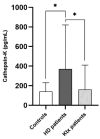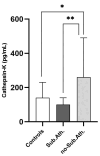Decreased Cathepsin-K Mirrors the Severity of Subclinical Atherosclerosis in Kidney Transplant Recipients
- PMID: 39077719
- PMCID: PMC11262360
- DOI: 10.31083/j.rcm2309311
Decreased Cathepsin-K Mirrors the Severity of Subclinical Atherosclerosis in Kidney Transplant Recipients
Abstract
Background: In kidney transplantation (Ktx) recipients, cardiovascular (CV) disease remains the leading cause of death. Abnormal carotid intima-media thickness (IMT) represents a valid indicator of incipient atherosclerosis also in this setting. Cathepsin-K (CatK) is a cysteine protease involved in vascular remodelling, as well as in progressive atherosclerosis. In this study we evaluated clinical predictors of CatK in Ktx recipients, with a particular focus on its possible relationships with subclinical atherosclerosis.
Methods: Circulating CatK was measured in 40 stable Ktx recipients together with several laboratory, clinical and echocardiography parameters. 30 healthy subjects and 30 hemodialysis (HD) patients served as controls for CatK values. Carotid IMT was measured in Ktx and these subjects were then categorized according to age-gender reference cut-offs of normal IMT.
Results: CatK levels were similar in Ktx recipients and healthy subjects but significantly reduced as compared to HD (p = 0.0001). In Ktx, at multivariate analyses CatK was associated with the LV end-diastolic volume (LVEDVi) ( = 0.514; p = 0.05), Ktx vintage ( = -0.333; p = 0.05) and mean IMT ( = -0.545; p = 0.05); this latter robust inverse association was confirmed also in another multivariate model with IMT as the dependent variable. Logistic regression analyses confirmed the beneficial meaning of CatK increase towards subclinical atherosclerosis [Odds Ratio (OR) 0.761; 95% Confidence Interval (CI) 0.569-0.918, p = 0.04]. At Receiver Operating Characteristics (ROC) analyses, CatK held a remarkable discriminatory power in identifying Ktx patients with abnormally increased IMT [Area Under the Curve (AUC) 0.763; 95% CI 0.601-0.926; p = 0.001]).
Conclusions: In Ktx recipients, reduced CatK levels reflect the time-dependent improvement in the uremic milieu, cardiac adaptations and, above all, the severity of subclinical atherosclerosis. CatK measurement in Ktx may therefore hold significance for improving early CV risk stratification.
Keywords: Cathepsin-K; carotid intima-media thickness; kidney transplantation; subclinical atherosclerosis.
Copyright: © 2022 The Author(s). Published by IMR Press.
Conflict of interest statement
The authors declare no conflict of interest. Davide Bolignano is serving as one of the Editorial Board members of this journal. Giuseppe Coppolino is serving as one of the Editorial Board members and Guest editors of this journal. We declare that Davide Bolignano and Giuseppe Coppolino had no involvement in the peer review of this article and have no access to information regarding its peer review. Full responsibility for the editorial process for this article was delegated to Brian Tomlinson.
Figures




References
-
- Gansevoort RT, Correa-Rotter R, Hemmelgarn BR, Jafar TH, Heerspink HJ, Mann JF, et al. Chronic kidney disease and cardiovascular risk: epidemiology, mechanisms, and prevention. Lancet . 2013;382:339–352. - PubMed
-
- Ojo AO, Hanson JA, Wolfe RA, Leichtman AB, Agodoa LY, Port FK. Long-term survival in renal transplant recipients with graft function. Kidney International . 2000;57:307–313. - PubMed
-
- Dudziak M, Rawicz-Zegrzda D, Jankowska M, Dębska-Ślizień A, Wołyniec Z, Rutkowski B. Tissue Doppler Imaging and Intima-Media Thickness as Noninvasive Methods of Cardiovascular Risk Stratification in Patients after Kidney Transplantation. Transplantation Proceedings . 2016;48:1535–1538. - PubMed
-
- Boots JM, Christiaans MH, van Hooff JP. Effect of immunosuppressive agents on long-term survival of renal transplant recipients: focus on the cardiovascular risk. Drugs . 2004;64:2047–2073. - PubMed
LinkOut - more resources
Full Text Sources

